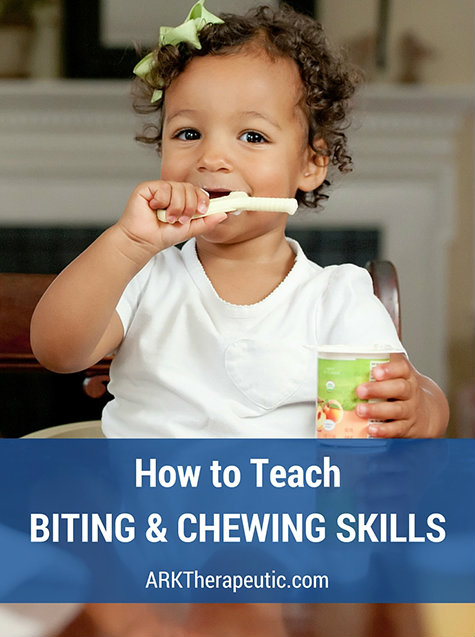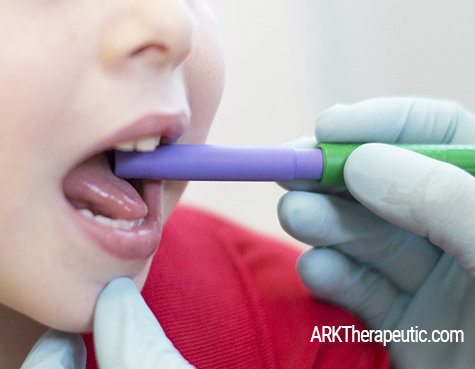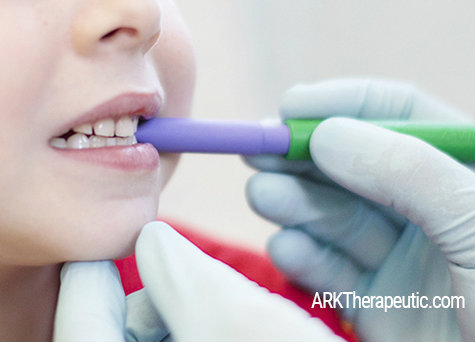Teaching the Concept of Biting and Chewing
Posted by Debra C. Lowsky, MS, CCC-SLP on 22nd Feb 2012
For infants, learning how to bite and chew is a crucial stage of feeding development. At approximately 5-6 months of age, babies begin using their fingers and mouths for oral exploration using a bite and release pattern. The development of biting and chewing continues from this point on, with the baby refining the movements of the jaw, tongue, and lips. When infants miss a part of this developmental process, intervention may be necessary to develop the ability to bite and chew.
.

.
1. One of the ways I like to begin chewing therapy for toddlers is to provide them with the opportunity to mouth oral motor chew tools (the Grabber, Y-Chew, Probe, and/or Animal Tips). These tools were specifically designed to increase oral awareness, to provide stimulation and tactile sensation, and to exercise the lips, cheeks, tongue, and jaw. Through oral exploration, the child just might begin to bite on his/her own, and from there you can progress to chewing.
2. Demonstrate how to bite so that the child can see and learn what the word actually means. Knowing the vocabulary will be an important part of therapy as you encourage the child to bite and chew. Over-exaggerate the movement to help communicate the concept. Use actual food when illustrating/showing. You can also use puppets with mouths to help illustrate biting (and later chewing). Take turns with the child to feed the puppet. Make it fun and playful. Make a bite sound or a glottal /um/ sound. Try having the child feed you.
3. A vertical chewing pattern (an up-and-down opening and closing of the mouth) will begin to develop first. Place either a Grabber or Y-Chew in between the molar area and assist the jaw to open and close. Use the word ‘bite’ as you are directing the jaw to close on the tool being used. Use a mirror for the child to watch himself/herself and you demonstrating a bite. Discontinue using the mirror if it becomes too distracting.
4. Once the child knows the vocabulary word ‘bite’ and can perform the skill, add the word ‘chew.’ Have the child place his/her hands on your jaw to feel you bite and chew. This is to give visual AND tactile feedback to better understand the concept. You may have to put your hands over his/hers to assist.
5. Once the child understands the concept of chewing, you can start practicing it with him/her. Place a Grabber or Y-Chew between the premolars and instruct the child to chew. You may have to guide the jaw to open and close. Work up to 20-25 chews in a row on each side of the mouth. For added oral awareness through vibration, you can also use the Z-Vibe with a Bite-n-Chew Tip.
6. If using a Grabber, have the child bite and chew on the loop as well. If using a Y-Chew, place the handle sideways across the front teeth. This works both sides of the mouth at once for bilateral chewing and jaw strength and stability.
7. Alternate sides to promote the development of a rotary chewing action. Have the child bite and chew 3-5 times on one side of the mouth and then switch to the other side. Remember to have the chew tools placed to the side of the mouth, in between the pre-molar area. As the child progresses, move the Grabber or Y-Chew to the back molar area where the chewing of foods occurs. If the child gags, move back toward the bicuspids and slowly, over time, progress to the molar area.
.


.
8. Once you are comfortable with the child’s ability to bite and chew, dip the chew tools into puréed or sticky foods and continue the biting and chewing exercises. Pairing these tools with real food helps to bridge the gap between practicing chewing and actually chewing real food. If using the Z-Vibe, you can also put food inside a Bite Tube Tip (pictured above) - when the child bites down, they'll be 'rewarded' with a taste of food to help connect the concept of chewing to getting food.
9. To assist with texture acceptance, begin using the smooth Grabber and progress to the Textured Grabber. Then dip the Textured Grabber into puréed or sticky foods and continue with biting and chewing exercises. If using the Z-Vibe, begin using the Bite-n-Chew Tip and progress to the Textured Bite-n-Chew Tip.
10. Have a drink handy in case the child needs to take a sip in between exercises.
.
It's important to note that some children may seem frightened to eat because they know they do not have the oral motor skills necessary to handle food. These children are reacting to a real fear and not just refusing to eat. In this instance, you may need to work on bolus formation, tongue awareness, tongue lateralization, etc. first. Other children may refuse to eat because of oral sensitivities, which would also need to be addressed. To learn more about food refusal related to oral motor and/or sensory issues, click here.
It's also important to note that anyone who has direct contact with the child (caregivers, early interventionists, etc.) should be on board to follow through with intervention strategies. The best results happen when therapy is reinforced at home in between sessions. The more opportunities presented, the better. However, the child should never be forced to mouth, bite, or chew. Teaching these skills takes time, lots of patience, and creative thinking.
Talk about the tools and let children feel them in their hands and on their arms first. Then progress to the face, cheeks, lips, and inside the oral cavity. Incorporate food play into your feeding sessions.
Last but not least, remember to praise, praise, praise. Use reinforcements that cater to the child’s interests. Get excited about progress, no matter how big or small it may seem.
.
Good luck!
Debbie
Debra C. Lowsky, MS, CCC-SLP
.

